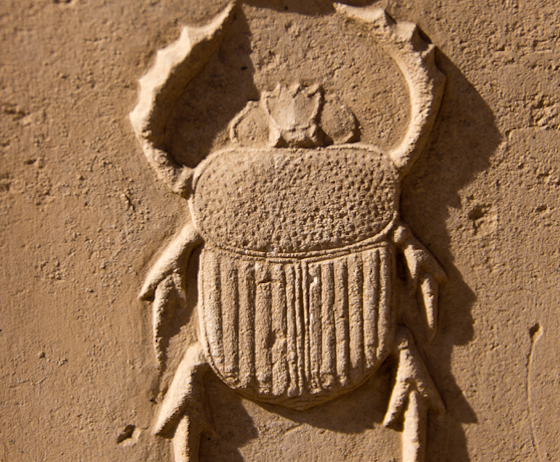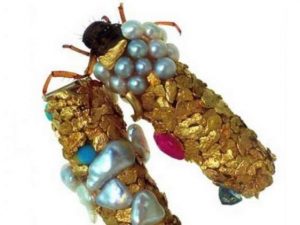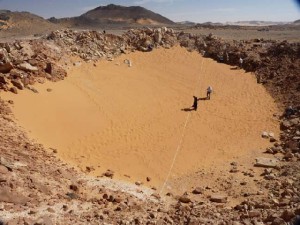 Scarab beetles, or dung beetles, were sacred to the ancient Egyptians. These insects rolled balls of dung across the earth just as the sun god Ra rolled across the sky.
Scarab beetles, or dung beetles, were sacred to the ancient Egyptians. These insects rolled balls of dung across the earth just as the sun god Ra rolled across the sky.
Scarabs were seen as earthly manifestations of heavenly movement. A team of scientists from South Africa and Sweden recently published a study indicating that there was a grain of truth in this belief. They found that these beetles use celestial navigation to roll their balls of dung in a straight path. The beetles orient themselves with star clusters and the wide band of star light we know as the Milky Way.
The Scarab beetle’s Egyptian name Kheper was associated with stability in transformation and was used in the names of pharaohs such as Thutmose III (Mn-Kheper-Re.) These insects and their artistic representations were fashioned into jewelry. Scarabs were also used as seals to protect written documents.
Scarab beetles can walk a straight line
Even on moonless nights some species roll their dung in surprisingly straight lines. They do this order to minimize the energy spent weaving through mobs of other dung-rolling beetles. They’re like shoppers trying to find the shortest path out of a crowded market.
While dung-pushing humans might focus on the task at hand, scarab beetles literally have their eyes on the stars. By using a planetarium to simulate the night sky, these scientists were able to determine that polarized sky light, the position of the sun, bright star clusters as well as the Milky Way were all used as cues to dung beetle navigation.
This is the first time celestial navigation has been seen in insects but the scientists believe it is common. This has environmental implications because even moderate light pollution can completely wash out all but the brightest stars – is light pollution the end of Arabian Nights? If you’ve ever seen the Milky Way consider yourself fortunate. Four billion people and untold billions of dung beetles live under too much light pollution to see their own galaxy.
When a 1994 earthquake knocked out power to Los Angeles people who had never seen the Milky Way dialled emergency numbers and worried that the dimly glowing “silver cloud” meant something was terribly wrong with the night sky.
The Milky Way as a path
In many folktales the Milky Way is described as it appears, a glowing pathway across the night sky. But no one really knew where this path was or where it led. Aristotle believed it was composed of starry vapors drifting through the upper atmosphere like graffiti overspray from when stars were painted onto the celestial dome.
But Arabian astronomer Alhazen (965-1037 A.D.) tried to measure the parallax of this ghostly band of starlight known in Arabic as Darb Al-Tabbāna (Haymaker’s way.) Alhazen found no parallax and concluded that it must be very far away.
Medieval Islamic astronomers such as Ibn Qayyim Al-Jawziyya, Abū Rayhān al-Bīrūnī and Ibn Bajjah concluded that the Milky Way was composed of distant stars very close together.
Why is the moon not following me?
When navigating by electric light instead of starlight, insects face the problem of parallax. The moon and stars are very far away so they maintain their angle in the sky as we move under them. But the angle to nearby lights changes based on the observer’s position.
If an insect navigator uses its biological sextant to maintain a constant angle to a relatively nearby electric light, it would find itself spiraling into that light. This is exactly happens to moths, flies and other night-flying insects when they circle electric lights. A light that isn’t infinitely distant must be as strange to them as the feeling that the moon is following us is to humans.
So the next time you find yourself pushing a ball of dung through a crowd on a dark night, keep your gaze on the stars and follow in the footsteps of the scarab beetle.
Dung beetles use the milky way for navigation was published in the journal Current Biology by Marie Dacke, Emily Baird, Marcus Byrne, Clarke H. Scholtz and Eric J. Warrant.




This is very helpful info. I need to say I like looking over this a great deal. It can benefit me to become better grasping on the subject. It is all well and good produced. I’ll definitely search for these materials very interesting. Ideally you could provide much more eventually.